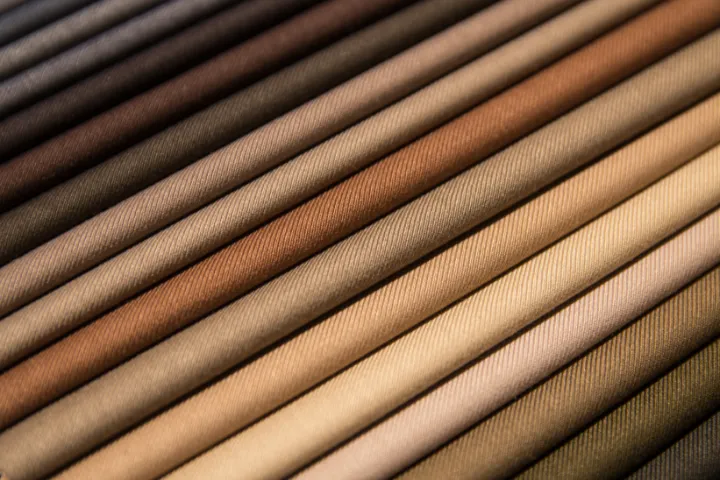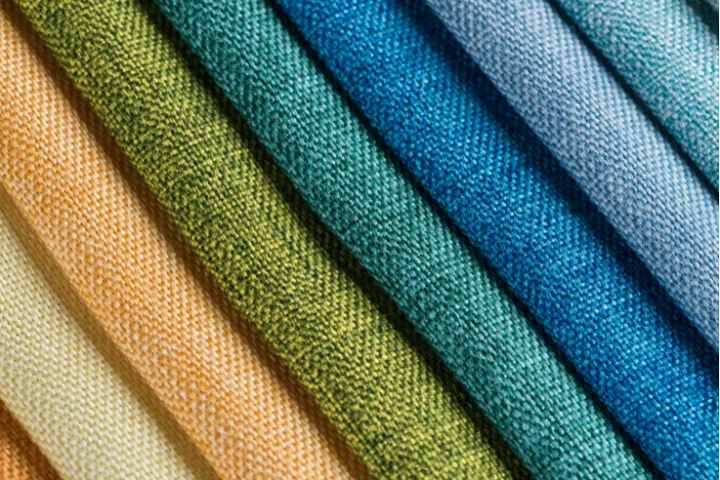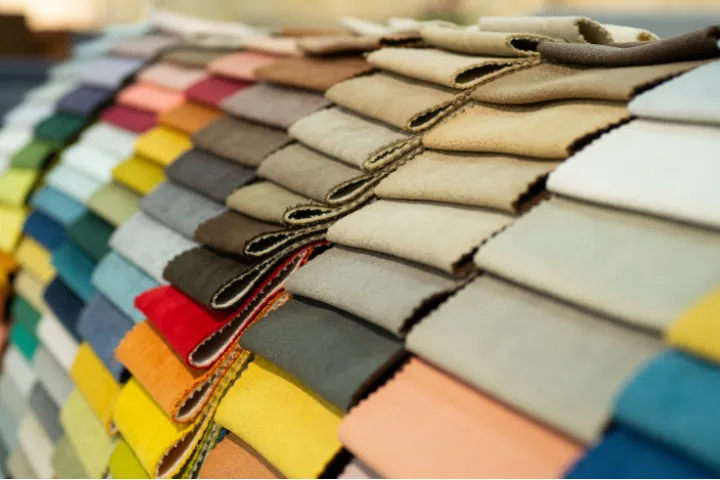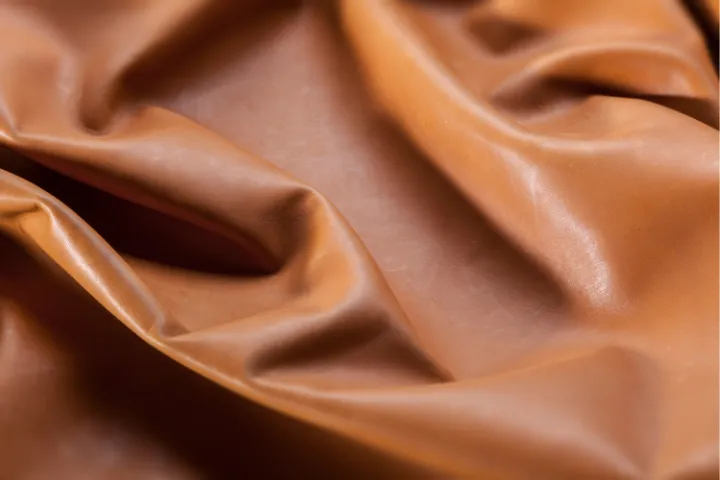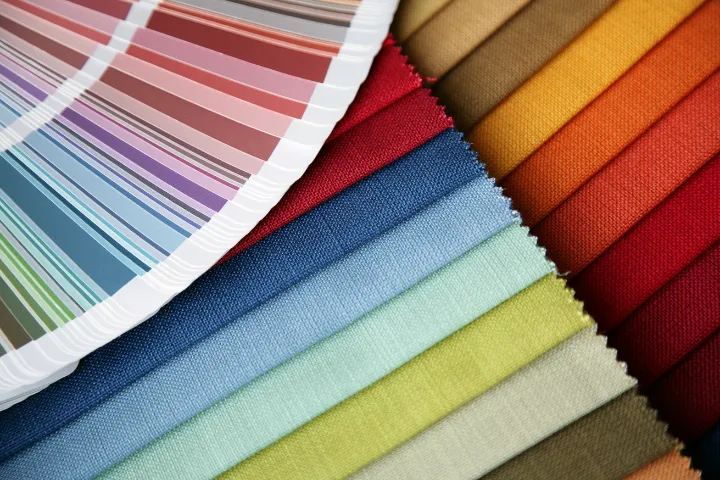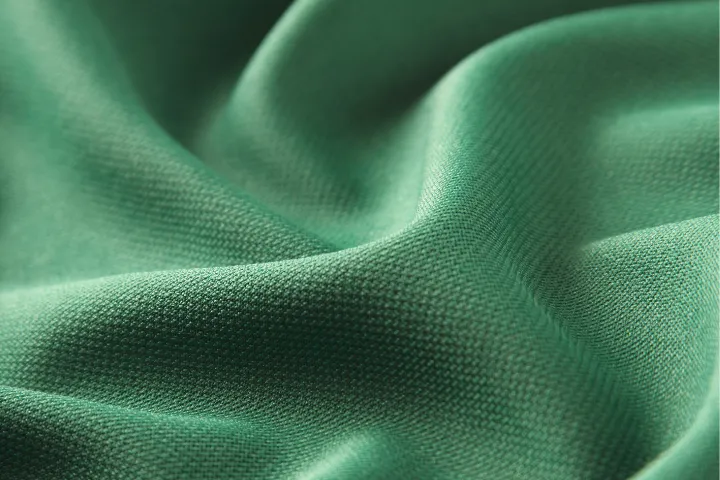Introduction
Have you ever picked up a t-shirt and known instantly that it was high quality? Or felt the inside of a luxury leather handbag and noticed how the lining felt both soft and strong? That feeling of quality often comes down to one simple factor: the fabric’s weight. In the world of textiles, we measure this with a metric called GSM. It is the secret number that determines how a fabric feels, how it performs, and how long it will last. Understanding GSM is crucial for anyone who makes or buys high-quality goods.
GSM stands for “grams per square meter.” It is a standard measurement of fabric weight and density. A higher GSM means a heavier, denser fabric, while a lower GSM indicates a lighter, thinner material. This single number influences a fabric’s durability, feel, and suitability for different applications, from a lightweight t-shirt to the sturdy canvas lining inside a premium leather bag. Understanding GSM is key to assessing fabric quality.
In 2025, consumers are smarter than ever. They demand transparency and want to know what their products are made of. For brands, especially in the premium leather goods market, every detail matters. The lining of a wallet or the reinforcement in a belt is just as important as the leather itself. This guide will demystify GSM completely. We will explain what it is, how it’s measured, and how to choose the right fabric weight for any application. Get ready to learn the secret language of fabric quality.
What is GSM in Fabric?
GSM stands for **Grams per Square Meter**. It is a simple, standard measurement of a fabric’s weight. A higher GSM number means the fabric is heavier and denser. For example, a lightweight t-shirt might have a GSM of 150, while a heavy canvas bag could be 400 GSM. It is a key indicator of a fabric’s quality, feel, and durability, but it is not the same as thickness.
A Detailed Definition
GSM is one of the most important terms in the textile industry. It tells you exactly how much one square meter of a fabric weighs in grams. Think of it like paper weight. You know that a heavy cardstock feels different from a thin piece of printer paper. GSM does the same thing for fabrics. It gives us a number to understand the density of the material. This simple measurement helps designers, manufacturers, and consumers judge a fabric’s quality and decide if it is right for a specific purpose.
The Science Behind the Number
A fabric’s GSM is not a random number. It is the result of several factors working together to determine the final density of the material. These include:
- Fiber Content: Different fibers have different natural weights. For example, cotton is generally heavier than polyester.
- Yarn Thickness: Thicker yarns will create a heavier fabric with a higher GSM.
- Weave Tightness: A tightly woven or knitted fabric will have more material packed into a square meter, which increases its GSM.
So, a high GSM fabric is not just thick; it is dense. This density is what gives it its strength and durability.
Is GSM the Same as Fabric Thickness?
No. This is a common point of confusion. While a higher GSM fabric is often thicker, GSM measures weight, not height. Two fabrics could have the same thickness, but if one is made from a denser fiber, it will have a higher GSM.
For example, a fluffy, loosely woven wool might feel thick, but a tightly woven canvas of the same thickness will be much heavier and have a higher GSM. GSM gives you a more accurate measure of the material’s substance.
GSM in Leather Products
While we think of leather goods as being all about the hide, the fabrics used inside are just as important. In a premium leather bag, the lining needs to be both luxurious and tough. A lightweight cotton lining of around 100 GSM might feel soft, but it could tear easily. That’s why many high-end brands, like those Hoplok Leather works with, might choose a more durable lining with a higher GSM. For a leather belt that needs to be strong, a heavy canvas reinforcement of 400 GSM might be used on the inside. In a slim leather wallet, a very low GSM fabric is needed for the pockets to keep it from feeling bulky. GSM helps manufacturers choose the perfect fabric to complement the quality of the leather.
The History and Evolution of GSM Measurement
The history of GSM measurement evolved from simple, traditional weighing methods in textile mills to a globally recognized standard. The shift from imperial units like ounces per square yard (oz/yd²) to the metric GSM system was driven by the need for a universal standard in global trade. Today, it is a crucial tool for quality control in industries from fashion to manufacturing.
From Traditional Weighing to a Global Standard
For centuries, textile mills used various local methods to weigh fabric. These systems were often inconsistent. They made it difficult to trade materials internationally. The need for a universal standard became clear as the textile industry grew. The adoption of the metric system in the 20th century provided the perfect solution. Grams per square meter (GSM) offered a simple, precise, and easily understood way to measure fabric weight anywhere in the world.
The Shift from Imperial to Metric
The main competitor to GSM has always been the imperial measurement of ounces per square yard (oz/yd²). While still used in the United States, the rest of the world has largely adopted the metric GSM system. Several key factors drove this shift:
- Global Trade: As manufacturing became more global, a single, universal standard was needed to ensure clear communication between suppliers and buyers.
- ISO Standards: International organizations like ISO promoted the use of the metric system for its simplicity and precision.
GSM in the Modern Era
Today, GSM is more than just a technical measurement. It’s a benchmark for quality that influences both design and consumer perception.
In the world of fast fashion, brands often use lower GSM fabrics to keep costs down. In contrast, sustainable and luxury brands often highlight a higher GSM as a sign of quality and durability. And in the leather goods industry, GSM is crucial for creating high-performance hybrid materials. For example, a leather bag might use a high-GSM canvas for its strap to provide strength. It might also use a low-GSM silk for its lining to provide a touch of luxury. Modern digital tools have made measuring GSM incredibly precise. This makes it an essential part of modern quality control.
How is GSM Measured and Calculated?
Professionals measure GSM by cutting a precise circular sample of fabric with a **GSM cutter**. They then weigh this sample on a high-precision digital scale. The formula is simply the fabric’s weight in grams divided by its area in square meters. While labs use specialized tools for accuracy, you can approximate it at home with a ruler and a kitchen scale. This simple calculation is key to quality control in textiles.
A Step-by-Step Guide
Measuring GSM is a straightforward process. In a professional setting, technicians follow these steps to get an accurate result:
- Cut a Sample: They use a tool called a GSM cutter. This device cuts a perfect circular sample of the fabric, usually 100 square centimeters in area.
- Weigh the Sample: They place the circular sample on a high-precision digital scale to get its weight in grams.
- Calculate the GSM: They use a simple formula to find the final number. For a 100cm² sample, the formula is: **Weight of the sample (g) x 100 = GSM**.
Tools of the Trade
In a lab or factory, technicians use specialized tools for perfect accuracy. However, you can get a rough estimate at home. Simply cut a square of fabric (for example, 10cm x 10cm). Then, weigh it on a sensitive kitchen scale. Finally, use the formula to calculate the GSM. While not as precise as a lab test, this can give you a good idea of the fabric’s weight.
Important Conversions
While most of the world uses GSM, the United States often uses ounces per square yard (oz/yd²). Knowing how to convert between the two is very helpful.
The conversion is simple. To get from one to the other, you can use these formulas:
- To convert GSM to oz/yd²: GSM x 0.0295 = oz/yd²
- To convert oz/yd² to GSM: oz/yd² x 33.906 = GSM
Accuracy and Consistency
It is important to know that a fabric’s weight can vary slightly. Most manufacturers allow for a small tolerance of about ±5%. Factors like humidity can also affect a fabric’s weight, as natural fibers can absorb moisture from the air. To ensure consistency, manufacturers test fabric samples from different parts of a roll. This is especially important for the linings of leather goods. A consistent GSM ensures that every bag or wallet has the same high-quality feel.
Factors Influencing GSM in Fabrics
Several key factors determine a fabric’s GSM. The **type of fiber** is crucial, as natural fibers like cotton are denser than synthetics like polyester. The **weave or knit structure** also plays a big role; a tighter weave increases GSM. Finally, **finishing processes** like dyeing or adding a protective coating can add weight and increase the final GSM of the material.
Yarn and Fiber Types
The journey to a fabric’s final weight begins with its most basic component: the fiber. Different fibers have different natural densities.
- Natural Fibers: Cotton and wool are naturally heavier fibers. This means they will generally produce a fabric with a higher GSM than synthetics of the same thickness.
- Synthetic Fibers: Materials like polyester and nylon are lightweight. They can be woven tightly to create a high GSM, but their base weight is lower.
This is important for leather goods. A brand might choose a cotton canvas lining for a bag when they want a sturdy, high-GSM feel. They might choose a lower-GSM polyester for a wallet lining to reduce bulk.
Weave and Knit Structures
How the yarns are put together is the next major factor. A tightly packed structure will always result in a higher GSM.
Think of it like this: a dense, tight weave like denim packs a lot of yarn into a small space, giving it a high GSM. A loose, airy knit, like in a sweater, has more space between the yarns, resulting in a lower GSM.
This is why a heavy canvas used for reinforcing a leather belt has a very high GSM. Its tight weave is what gives it its strength.
Finishing Processes
A fabric is not finished until it has been dyed and treated. These final steps can also add to its weight. Dyeing the fabric can add a small amount of weight from the dye particles themselves. More significantly, any special coatings, such as a water-resistant finish applied to the lining of a bag, will add another layer to the fabric, increasing its final GSM.
Factors Summary Table
| Factor | How it Increases GSM | How it Decreases GSM |
|---|---|---|
| Fiber Type | Using dense fibers like cotton or wool. | Using lightweight fibers like polyester. |
| Weave/Knit | A tight, dense weave or knit. | A loose, open weave or knit. |
| Finishing | Adding heavy dyes or coatings. | Washing processes that remove fibers. |
GSM Ranges and Classifications: A Comprehensive Chart
Fabrics are classified by their GSM into different weight categories. Lightweight fabrics (under 150 GSM) like chiffon are used for delicate items like wallet linings. Midweight fabrics (150-250 GSM) like t-shirt jersey offer a balance of durability and comfort. Heavyweight fabrics (over 250 GSM) like canvas or denim are used for durable applications like the reinforcement inside a leather bag strap.
We can group fabrics into general categories based on their GSM. This helps designers and consumers quickly understand a material’s likely feel and function.
Lightweight Fabrics (Under 150 GSM)
These fabrics are light, airy, and often sheer. They have a beautiful drape. They are perfect for warm weather. However, they are not very durable.
- Examples: Chiffon (30-50 GSM), Organza (40-60 GSM), lightweight cotton lawn (70-100 GSM).
- Leather Goods Use: A low GSM silk or cotton lawn is perfect for the luxurious, non-bulky lining of a high-end leather wallet or clutch.
Midweight Fabrics (150 – 250 GSM)
This is the most common range for everyday apparel. These fabrics offer a perfect balance of comfort, durability, and substance.
- Examples: Standard t-shirt jersey (150-200 GSM), chambray (150-200 GSM), flannel (180-250 GSM).
- Leather Goods Use: A 200 GSM cotton twill is an excellent choice for the main lining of a leather handbag. It is durable enough to withstand daily use but still soft to the touch.
Heavyweight Fabrics (Over 250 GSM)
Heavyweight fabrics are the workhorses of the textile world. They are built for durability and structure, not for delicate drape.
These materials are thick, strong, and often have a rugged texture.
- Examples: Denim (300-400 GSM), canvas (250-450 GSM), heavy fleece (300-400 GSM).
- Leather Goods Use: A 400 GSM canvas is the ideal material for reinforcing the strap of a leather messenger bag or for the durable backing of a sturdy leather belt.
Fabric Weight and Feel Table
| GSM Range | Feel & Drape | Suitability for Leather Accessories |
|---|---|---|
| Under 150 GSM | Light, airy, and often sheer. Drapes beautifully. | Ideal for luxurious, non-bulky linings in wallets and small clutches. |
| 150 – 250 GSM | Balanced, comfortable, with some substance. | The perfect all-purpose weight for the main lining of handbags and backpacks. |
| Over 250 GSM | Heavy, structured, and rugged. Does not drape. | Excellent for durable reinforcements in bag straps and belts. |
GSM in Different Fabric Types
The typical GSM of a fabric depends on its fiber and construction. For example, a standard cotton t-shirt is around 150-200 GSM. A warm wool sweater might be 300-400 GSM. Lightweight synthetics for athletic wear are often 120-180 GSM. For specialty items, a plush towel can be 400-600 GSM, while a durable canvas used to reinforce a leather bag can be 400+ GSM.
Cotton and Blends
Cotton is a versatile and popular fiber. Its GSM can vary widely. A lightweight cotton voile might be 70 GSM, perfect for a summer scarf. A standard t-shirt is usually between 150-200 GSM. Heavyweight cotton canvas can easily exceed 400 GSM.
In leather goods, a midweight cotton twill (around 200 GSM) is a fantastic choice for a durable yet soft handbag lining. For a slim wallet, a lightweight cotton poplin (100-120 GSM) keeps the profile thin.
Wool and Knits
Wool is known for its warmth, which often means a higher GSM. A lightweight merino wool base layer might be 150 GSM. A thick, chunky knit sweater, however, could be 400 GSM or more. The loose structure of a knit can sometimes be misleading, which is why GSM is such a useful measure of the actual substance of the material. For the padded interior of a luxury leather camera bag, a 300 GSM felted wool provides excellent cushioning.
Synthetics and Microfiber
Synthetics like polyester and nylon are lightweight but strong. This allows them to have a lower GSM while still being very durable. Athletic wear, for example, often uses synthetics in the 120-180 GSM range for a fabric that is both tough and breathable. In leather accessories, a water-resistant nylon with a GSM of around 150 is an excellent choice for the lining of a belt or a travel bag that needs to withstand the elements.
Specialty Fabrics
Some fabrics are defined by their very high GSM. Upholstery fabrics, for instance, need to be extremely durable and often have a GSM of 300 or more. A plush, absorbent bath towel is a perfect example of a high-GSM product, typically ranging from 400 to 600 GSM. The higher the GSM, the more water it can absorb. For technical applications, like the canvas used to reinforce a heavy-duty leather tool belt, the GSM might be 500 or higher to ensure maximum strength.
GSM vs. Other Fabric Weight Measurements
GSM is the global standard for fabric weight, but it’s not the only measurement. In the US, **ounces per square yard (oz/yd²)** is common. Other metrics like **thread count** (for softness in sheets) and **denier** (for fiber thickness in technical fabrics) measure different qualities. GSM is the best overall measure of a fabric’s density and durability, especially for linings in leather goods.
GSM vs. oz/yd²
This is the most direct comparison. GSM is the metric standard, while oz/yd² is the imperial standard. Most of the world uses GSM for its simplicity and universal understanding. The US market, however, still frequently uses oz/yd². A good manufacturer, like Hoplok Leather, is familiar with both systems to serve a global clientele. Knowing the simple conversion formulas can help you easily compare fabrics from different sources.
Thread Count, Denier, and Tex
These other common terms measure different things, and they complement GSM rather than replace it.
- Thread Count: This measures the number of threads woven into one square inch of fabric. It is a measure of fineness and softness, not weight. It is most commonly used for bed sheets.
- Denier: This measures the thickness and weight of a single fiber. It is often used for technical fabrics like the nylon in a backpack or the lining of a durable leather travel bag. A higher denier means a stronger fiber.
Myths: Does Higher GSM Always Mean Better Quality?
No. This is the most important myth to debunk. A higher GSM only means a heavier fabric; it does not automatically mean it is a “better” fabric. The right GSM always depends on the intended use.
For example, a 100 GSM silk lining in a luxury leather wallet is much higher quality than a 200 GSM polyester lining. The silk is a more premium fiber. Similarly, a lightweight 150 GSM t-shirt is perfect for summer, while a 300 GSM t-shirt would be uncomfortably heavy. Quality is a balance of the right fiber, the right weave, and the right weight for the job.
Advantages and Disadvantages of Different GSM Levels
The GSM level of a fabric involves a trade-off. Low GSM fabrics are lightweight, breathable, and affordable, making them ideal for summer wear or delicate linings. However, they are less durable. High GSM fabrics are extremely durable, warm, and structured, perfect for outerwear or reinforcing leather goods, but they are heavier, less breathable, and more expensive.
Advantages of Low GSM Fabrics
Lighter fabrics offer a unique set of benefits. These make them the perfect choice for specific applications.
- Breathability and Comfort: Their open structure allows air to circulate freely. This makes them ideal for summer clothing.
- Lightweight Feel: They don’t weigh you down. This is perfect for activewear. It is also great for the lining of a leather wallet where you want to minimize bulk.
- Better Drape: Low GSM fabrics flow and move beautifully. This makes them a favorite for elegant designs.
- Cost-Effectiveness: Because they use less raw material, they are often more affordable.
Disadvantages of Low GSM Fabrics
However, that lightweight feel comes with some significant drawbacks.
- Lower Durability: Fewer fibers mean less strength. Low GSM fabrics are more prone to tearing. They will not last as long as their heavier counterparts.
- Less Insulation: Their airy nature means they provide very little warmth.
Advantages of High GSM Fabrics
Heavyweight fabrics are the champions of durability and substance.
- Enhanced Durability: A high GSM means a dense, strong fabric. It can withstand years of heavy use. This is why a high GSM canvas is perfect for reinforcing a leather belt.
- Warmth and Structure: Their dense structure traps air. This provides excellent insulation. They also hold their shape well, which is ideal for more tailored looks.
Disadvantages of High GSM Fabrics
The strength of a high GSM fabric is also its main weakness. The same density that makes it durable can also make it heavy, stiff, and less comfortable for certain applications.
A high GSM fabric is often less breathable. It can also feel bulky. For the lining of a fine leather handbag, a 400 GSM canvas would be too stiff and heavy. This would ruin the feel of the product.
How to Choose the Right GSM for Your Needs
Choosing the right GSM depends on the product’s use. For a t-shirt, 150-220 GSM offers a good balance. For a durable leather bag lining, 100-200 GSM works well. And for a strong belt backing, 250-400 GSM is ideal. Always consider the balance between weight, durability, and comfort. A higher GSM is not always better; it must match the product’s function.
By Garment and Accessory Type
The first step is to match the weight to the product. Different items have different needs.
- T-Shirts: A lightweight 150 GSM is great for summer. A premium, more durable feel comes from a 220 GSM shirt.
- Hoodies: Look for 250-350 GSM for a good balance of warmth and comfort.
- Leather Bag Linings: A 100-200 GSM cotton or polyester provides a lightweight feel. For extra durability, a 250-400 GSM canvas is a great choice for reinforcements.
- Leather Belts and Wallets: A 150-300 GSM backing for a belt adds strength without too much stiffness. For a slim wallet, a light 80-150 GSM fabric is perfect for the interior.
By Activity and Season
How and when you will use the item also matters. A runner will want a low GSM, moisture-wicking fabric. A skier will need a high GSM fabric for warmth. For accessories, the same logic applies. A summer leather tote bag feels more luxurious with a light, breathable lining (under 200 GSM). A winter bag might benefit from a thicker, more insulated lining.
Budget and Quality
Remember, GSM is only one part of the quality equation. A high GSM fabric made from a low-quality fiber will not perform well. It is all about finding the right balance.
For a premium leather product, the fabric components should also be premium. Investing in a high-quality, mid-weight cotton lining will enhance the overall feel and longevity of a leather bag. This is a detail that luxury manufacturers, like Hoplok Leather, understand well.
Final Tips for Choosing
When in doubt, feel the fabric. Check the labels on items you already own and like. Consider how the fabric will feel and perform after washing. Most importantly, choose a GSM that complements the main material. A heavy, durable leather bag deserves a strong, high-quality lining to match.
Applications of GSM in Various Industries
GSM is a critical quality metric across many industries. In fashion, it distinguishes between lightweight summer wear and heavy winter coats. In home textiles, it determines the absorbency of towels and the durability of upholstery. For the leather goods industry, it is essential for selecting the right fabric linings—balancing luxury feel with durability in bags, belts, and wallets.
Fashion and Apparel
In fashion, GSM is king. It dictates how a garment drapes, feels, and performs. Fast-fashion brands often use lower GSM fabrics to keep costs down. Luxury brands, in contrast, will use a high GSM fabric to signal quality and durability. For hybrid leather-fabric jackets, a designer might pair a tough leather body with high-GSM wool sleeves for warmth and structure.
Home Textiles
GSM is just as important in the home. For bedding, a 200-400 GSM cotton provides a crisp, durable feel. For upholstery, a fabric needs to be very durable, so a GSM of 300+ is common. Towels are perhaps the best example of GSM in action: a cheap, thin towel might be 300 GSM, while a plush, luxury hotel towel will be 600 GSM or higher.
The Leather Goods Industry
For a manufacturer of premium leather goods like Hoplok Leather, GSM is a crucial part of the design process. The choice of lining is not an afterthought; it is essential to the final product’s quality and feel.
The right GSM ensures that a bag’s lining is strong enough to withstand daily use without tearing. It ensures that a belt’s backing is sturdy but still flexible. And it ensures that a wallet’s interior is slim and refined. GSM is the key to creating a product where every component works in harmony.
Myths and Misconceptions About GSM
The biggest myth about GSM is that higher is always better. This is not true. The ideal GSM depends entirely on the product’s intended use. A lightweight, low-GSM fabric is better for a summer shirt or a delicate wallet lining. Another myth is that GSM alone determines breathability; the fiber type and weave are just as important. Understanding this context is key to choosing the right fabric.
Myth: Higher GSM Always Equals Better Quality
This is the most common and most misleading myth. A high GSM simply means a heavier fabric. While this often correlates with durability, it is not a universal measure of quality. For example, a 100 GSM silk lining is far higher quality than a 300 GSM polyester lining. The fiber itself is more luxurious and performs better. The “best” GSM is the one that is most appropriate for the product’s function.
Myth: GSM Determines Breathability Alone
While a very high GSM fabric will be less breathable than a very low GSM one, the fiber and weave are more important factors. A 200 GSM linen, with its open weave, will be far more breathable than a 200 GSM polyester with a tight weave. For a leather bag with a fabric panel, choosing a naturally breathable fiber like cotton is just as important as choosing the right GSM.
Common Errors
People often confuse GSM with thread count, but they measure different things. GSM measures weight, while thread count measures the number of threads per square inch. Another common error is forgetting that fabrics, especially natural ones, can shrink after washing, which will increase their GSM as the fibers become denser.
Sustainability and Environmental Impact of GSM Choices
A fabric’s GSM has a direct impact on its sustainability. Higher GSM fabrics use more raw materials, water, and energy to produce. However, their durability means they last longer, reducing waste. The most sustainable choice often involves balancing a moderate GSM with eco-friendly fibers, like organic cotton or recycled polyester, especially for linings in long-lasting leather goods.
How Higher GSM Uses More Resources
It’s a simple equation: a heavier fabric requires more raw material to produce. Growing more cotton or producing more polyester uses more water, energy, and land. This means that, all else being equal, a 400 GSM canvas has a larger initial environmental footprint than a 200 GSM canvas. For brands focused on sustainability, choosing the lightest possible GSM that still meets the product’s durability needs is a smart way to reduce this impact.
Lifecycle Analysis: Durability vs. Disposability
The sustainability of a fabric isn’t just about its production; it’s about its entire lifecycle. A durable, high-GSM fabric that lasts for ten years is ultimately more sustainable than a low-GSM fabric that needs to be replaced every year.
This is especially true in the leather goods industry. A premium leather bag is designed to last for decades. Its lining must be able to keep up. Choosing a durable, mid-to-high GSM lining is a crucial part of creating a truly long-lasting, sustainable product.
Tips for Sustainable Choices
For brands and consumers looking to make the most eco-friendly choice, the key is to look beyond just the GSM number. Choosing a fabric made from recycled fibers, such as recycled cotton or polyester, is one of the most effective ways to reduce a product’s environmental footprint, regardless of its weight. Pairing a beautiful, durable leather with a lining made from recycled materials is a hallmark of a truly modern, conscious brand.
Frequently Asked Questions (FAQs)
Common questions about GSM focus on its meaning and relation to quality. GSM stands for **Grams per Square Meter**. A “good” GSM depends on the use; 150-200 is good for a t-shirt, while 400+ is good for a towel. A higher GSM is not always better, as it just means heavier. It is a measure of weight, not quality, though the two are often related. It is calculated by weighing a 1×1 meter sample of fabric.
What does GSM stand for in fabric?
GSM stands for Grams per Square Meter. It is a measurement of how much a one-meter by one-meter square of fabric weighs.
What is a good GSM for fabric?
A “good” GSM depends on the product. For a t-shirt, 150-200 GSM is a good balance. For a durable bag lining, 200-300 GSM is excellent. And for a plush towel, 400-600 GSM is considered high quality.
Is higher GSM better?
Not always. A higher GSM means a heavier and often more durable fabric, but this is not always desirable. For a summer dress or a wallet lining, a lower GSM is better.
How do you calculate GSM in fabric?
You calculate GSM by weighing a one-square-meter sample of fabric. In a lab, a 100cm² circular cutter is used, and the weight in grams is multiplied by 100.
What does 200 GSM mean in fabric?
200 GSM means that one square meter of that fabric weighs 200 grams. This is a typical midweight fabric, common for high-quality t-shirts or durable bag linings.
What is the difference between GSM and oz in fabric?
GSM is a metric measurement (grams per square meter), while oz (ounces per square yard) is an imperial measurement. They both measure fabric weight, but GSM is the global standard.
What GSM is considered heavy fabric?
Generally, any fabric over 250 GSM is considered heavyweight. Fabrics like denim (300+ GSM) and canvas (400+ GSM) fall into this category.
Does GSM affect fabric quality?
Yes, but it does not define it. GSM is an important indicator of a fabric’s substance and potential durability, but the quality also depends on the type of fiber and the quality of the weave.
Conclusion
GSM is more than just a technical term; it’s a powerful tool for understanding the quality, feel, and durability of a fabric. From the feather-light silk lining in a luxury wallet to the rugged canvas that reinforces a leather belt, this simple number tells a complex story about how a fabric is made and how it will perform. By moving beyond the myth that “higher is always better” and learning to choose the right GSM for the right purpose, you can make smarter, more informed decisions as a consumer and a creator.
In the world of premium leather goods, this attention to detail is what separates the good from the truly exceptional. A beautiful leather exterior deserves an interior that is just as thoughtfully chosen. At Hoplok Leather, with over 22 years of experience, we understand that every component matters. We are experts in sourcing and working with a wide range of fabrics to perfectly complement our custom leather creations, ensuring that every product we make is a testament to quality, inside and out. We invite you to explore the possibilities and see how the right materials can bring your vision to life.
Ready to Create a Product Where Every Detail Matters?
From the finest leathers to the perfect fabric linings, quality is in the details. At Hoplok Leather, we are experts in sourcing and manufacturing custom leather goods with the ideal materials to match your brand’s vision. Let our 22 years of experience help you create a product that stands for excellence, inside and out.



